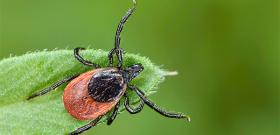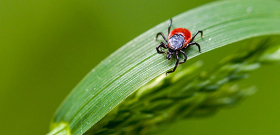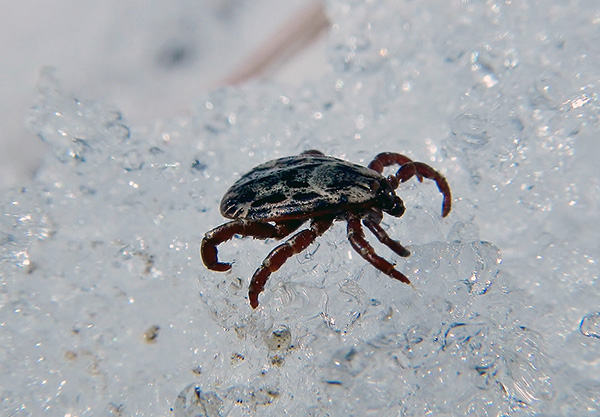
Ixodid ticks (Ixodidae), like all arthropods, are not able to independently maintain a constant body temperature. The main regulator for all processes of their vital activity, including the rate of growth and development, is the temperature factor.
The study of biotopes and pronounced natural locations in places where ticks hibernate made it possible to get an idea of the conditions for the existence of parasites at low temperatures. It should be noted that the optimal hygrothermal factors for the existence of the parasite are located in tropical latitudes. Due to the intensity of physiological processes in such conditions, the life of ticks here does not exceed one year.
On the territory of the Russian Federation and neighboring states, the life cycle of a tick takes place in several stages and lasts from 2 to 6 years, depending on the geographical latitude and climatic zone of habitat. Such a long life span provides for the presence of a special evolutionary protective mechanism - a kind of hibernation, which allows not to lose the ability to live during seasonal climate changes.
When unfavorable climatic conditions occur, the parasites pass into a special state - morphogenetic diapause, which helps them to safely endure wintering.
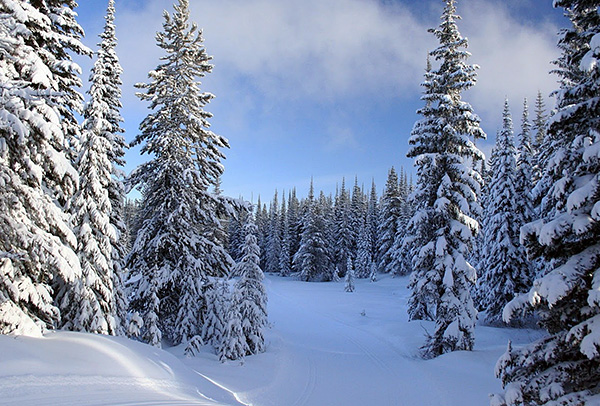
In the spring, after the end of the cold period, the ixodids wake up and activate their life processes.In middle latitudes, the activation of adults and their intermediate phases occurs at a temperature of +3 ... +5 degrees Celsius.
It's important to know
Single adults, hungry larvae and nymphs are able to start the activation process after hibernation at a temperature of -1.5°C. The greatest activity of parasites in early spring is observed in the places of the first thawed patches and open hills warmed by the sun's rays.
At all life stages, ixodid ticks are able to enter their body into a state of diapause upon the onset of a certain average daily temperature level. The signal for hibernation is not only a decrease in the average temperature, but also the duration of daylight hours, as well as a change in the relative humidity of the air.
In central Russia, the peak of seasonal parasite activity ends at the end of October, and already at the beginning of November, most of the tick population goes into hibernation.
Hungry individuals of all developmental phases, in contrast to engorged ones, are more resistant to low temperatures. Irreversible processes associated with metamorphosis and molting after blood feeding in most cases reduce the cold resistance of parasites.
Feeding on the eve of winter, females cannot control the activation of reproductive processes, and in any case they will produce offspring, but the eggs do not have sufficient cold resistance, so most of them die already at near-zero temperatures.

On a note
When staying for 30 days at a temperature of -2 degrees Celsius, the oviposition of the female ixodid tick dies by 99%.
Individuals that have fallen into a state of morphogenetic diapause are in a numb state until the onset of a period of steady snowmelt and the transition of the average daily temperature to a positive zone.
The timing of awakening and spring activation of the parasite largely depends on weather conditions and soil warming. In late March - early April, the first bites of parasites are recorded in central Russia.
Optimal conditions for wintering ixodid ticks
The main natural factors that encourage ticks to search for wintering places are the ambient temperature and the length of daylight hours. Photoperiodism inherent in many arthropods makes it possible to correctly estimate the time of onset of unfavorable temperatures and to find a place for wintering in a timely manner.

The choice of places for wintering in ixodid ticks is largely due to physiological characteristics and cold resistance. Despite the fact that the parasite is able to withstand a short stay at temperatures down to -25°C, its optimal conditions for wintering are in the zone of near-zero temperatures.
With a long stay in the zone of low temperatures, ice crystals are formed in the body of the parasite, which leads to its death.
It is interesting
The survival of ticks in the conditions of central Russia and more northern latitudes is possible only if there is a stable snow cover. With a snow cover thickness of 25-30 cm, the temperature at the soil surface does not drop below -6 degrees even in thirty-degree frosts. If the thickness of the snow cover reaches a value of 75 cm, then the temperature at the soil surface is on average -1°C.
Ticks always choose places for wintering where the likelihood of snow blowing by the wind is minimized.Such places are forest edges with low shrubs, small forest clearings with dense vegetation, or impenetrable dry lowlands with hilly relief, covered with young growth of deciduous trees.
When preparing for hibernation, the parasites choose areas of the terrain where the species composition of woody and shrubby plants forms a thick forest litter. The loose layer of the forest floor, moistened by autumn rains, serves as a breeding ground for aerobic bacteria and fungi. In the process of decomposition and decay, the remains of vegetation release a certain amount of thermal energy, thereby providing optimal conditions for the wintering of wood mites.
The most comfortable conditions for wintering of all life phases of ixodid ticks are provided by forest litter formed by young plantations of hardwoods such as aspen, birch, mountain ash, alder, and willow. The thick and loose litter formed by such plants has excellent thermal insulation properties, retains moisture and is not an obstacle to oxygen access.

In mature coniferous forests, the forest litter is not so attractive for wintering individuals due to its high density and low air permeability. In addition, fallen needles contain residues of phytoncides and resins, the smell of which ticks try to avoid. In old-growth coniferous forests of the middle belt, a significant part of the snow lingers in the upper tier on closed crowns, therefore, an insufficiently thick snow layer forms on the soil. It can also cause death of parasites in winter.
When choosing wintering sites, ticks avoid hard ground with exposed rocks, as well as wetlands, sphagnum moss, and dry areas dominated by sandy soils.
On a note
Many mites overwinter in the burrows of small rodents. In some cases, such parasites do not even enter diapause, but continue an active lifestyle. And even after the onset of spring, they do not disappear anywhere and do not look for new hosts for themselves, but continue to parasitize here on small vertebrates. A similar phenomenon occurs in the steppe regions with little snowy winters.
Natural factors that have a negative impact on the survival of parasites in the cold season
The most common reason for the death of the forest tick population is early November frosts, when the thickness of the snow cover is minimal or absent.
On a note
Snowless winters reduce the number of ticks in the natural focus by 60-70%. It takes 2-3 years to restore the population to its previous level (under favorable climatic conditions).
Meadow areas covered with short herbaceous vegetation do not provide reliable thermal insulation of places where ticks hibernate; therefore, pasture ixodids penetrate deep into soil cracks and rodent burrows with the onset of cold weather.
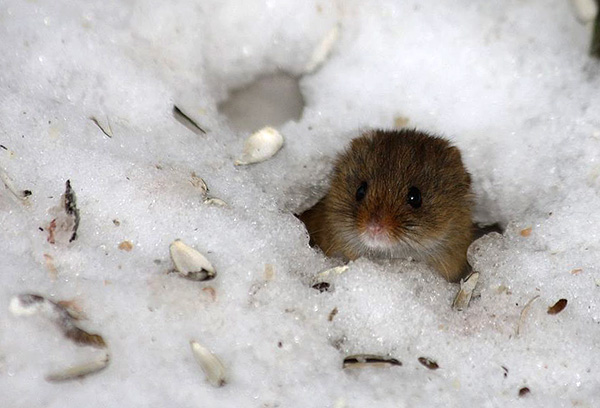
Excessive soil moisture significantly worsens the thermal insulation properties of tick habitats. Heavy autumn showers, followed by frosts, often lead to hypothermia and death of parasites.
But the greatest natural danger for the wintering of parasites is thaws with complete snowmelt and subsequent frosts. Such phenomena cause a significant decrease in the thickness of the snow cover and freezing of the soil to a great depth.
Features of wintering ticks at different life stages
The life of ixodid ticks is due to cyclicity. Each life phase has its own type of behavior, period of activity and method of hunting. Larvae, nymphs, and adults have their own distinctive food associations. This biological feature makes it possible to more densely cover the habitat and more rationally use the food resource.
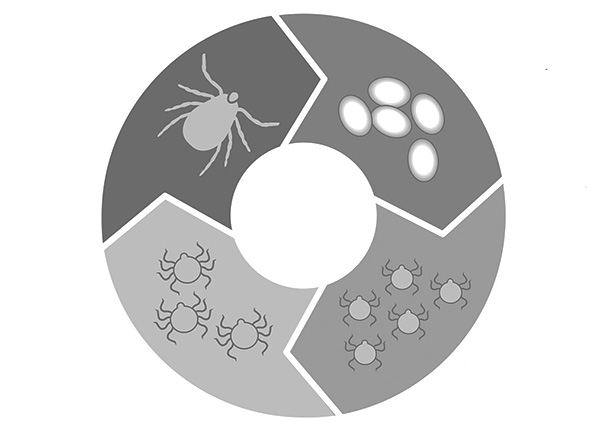
In the vast majority of cases, all life phases of ixodid ticks go through the wintering stage. The exception is populations with a one-year development cycle in tropical and subtropical latitudes with warm winters.
Hungry females show the greatest cold resistance. A long stay at a temperature of -2 ° C practically does not affect their vital functions.
The most vulnerable phase of the existence of the parasite is the engorged larva. Her death occurs in 3-5 days at a temperature of 7-10 degrees below zero.
Hungry larvae and engorged nymphs are slightly more resistant to freezing temperatures.
On a note
If the snow cover is blown out by strong winds in the area where ticks winter, the mass death of larvae and nymphs occurs first of all.
Winter activity of forest ticks in different climatic zones
The cold resistance of encephalitic ticks depends on the climatic zone of the permanent habitat of the population. In northern latitudes, parasites are most adapted to low temperatures.
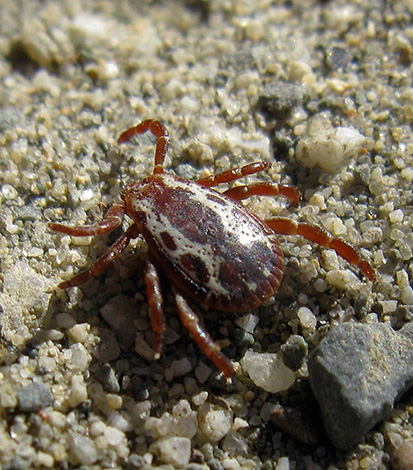
On the territory of Russia, the northernmost habitat of ticks is the coast of the Barents Sea.Tick populations that live in this harsh area overwinter in bird colonies, in the building substrate of seabird nests, and penetrate deep into rock crevices.
Harsh habitat conditions often serve to prolong the life of ticks and increase the time of existence of each phase. It is not uncommon for parasites to find no food for themselves throughout the summer and leave for the winter again.
Tick populations in Siberia are focal in nature. The survival of ixodids here depends on the stability of the snow cover and sufficient thermal insulation of the forest litter. In the taiga zone, parasites choose for wintering areas with mixed vegetation or bushy clearings, and avoid old-growth dry pine forests and open meadows.
In central Russia, the favorite wintering grounds for ixodid ticks are areas with secondary forest plantations, meadows overgrown with aspen and forest edges with dense shrubs.
In the south of our country, parasites hibernate for a relatively short period of time. In those regions where there is no stable snow cover, but frosts are possible, ticks make their way to the burrows of small vertebrates or underground voids for the winter.
In the steppe and semi-desert zone, ticks are found mainly only in river valleys or areas with relatively dense vegetation. The banks of the rivers overgrown with bushes and reeds serve not only as a convenient position for the waiting type of hunting, but also as a good place for wintering.
What danger to humans and animals are hibernating parasites
Although encephalitis mites are inactive during the winter and are in diapause, they can still pose a risk to humans and domestic animals.
A tick bite in winter is not uncommon, especially in rural areas where residents make hay to feed their pets. In addition, parasites often get into the food of animals along with hay.

In rare cases, infection with tick-borne encephalitis is possible through the use of raw milk from goats or cows, in the digestive system of which the causative agents of this dangerous disease have entered along with the carrier.
Ticks can enter farm buildings along with fallen leaves that are collected for pet bedding. In warm sheds where livestock lives, ticks can become active in the dead of winter and begin to search for prey. In this case, there is a threat of being bitten by both the animals and the person caring for the animals.
In all cases, the activation of ticks during wintering occurs only when it is physically moved to a warm room.
On a note
The probability that an encephalitic tick will be brought into the apartment with a New Year tree from the forest is negligible. Ticks do not live and almost never prey on spruces, they use tall grass and bushes to lie in wait for prey. Ticks often overwinter in cracks or hollows in large, thick trees, but young coniferous trees do not provide reliable shelter for parasites in winter.
Summing up, it is worth noting that over millions of years of their evolution, ixodid ticks have developed a very reliable mechanism for survival at low temperatures. The ability of parasites to predict the onset of cold weather in advance and to effectively find shelter allows them to survive even in the most severe winters.
Interesting facts about the life of ixodid ticks


